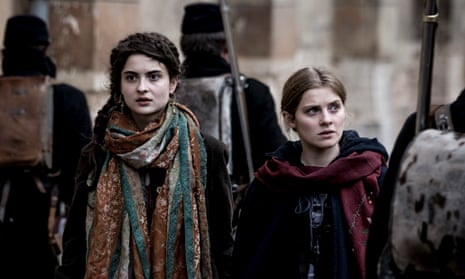This epic, eight-part swath of Danish military misadventure is easily identifiable to Danes by the year, hence its plain, Gregorian title. To the rest of us, 1864 may as well be a padlock code. But for those who know their Jutland history, those four numbers unlock a nightmare, with Danish soldiers flinching under endless cannonades in the trenches of the constitutionally contested Duchy of Schleswig-Holstein.
They were outnumbered, outgunned and outsmarted by the Prussian-Austrian army at places Danes now regard as synonymous with defeat: Dybbøl, Sønderborg, Als, Lundby … look how these chewy names now trip off my tongue, after I’ve been glued to writer-director Ole Bornedal’s slick, expensive reconstruction. If it all sounds a bit like being back at school, ask yourself: how often is history written by the losers? When it is, the result can be rousing episodes like The Charge of the Light Brigade and Gallipoli, movies where heroism and bravery are undercut by tragedy and futility.
Such comparisons may seem grand, but 1864 really is in television’s top rank, channelling the spirit of the ambitious German series Heimat, which chronicled a near century of tumult via episodic life in one rural village. It’s more tightly focused but similarly humanises the mass casualties of a conflict whose mud, letters home and shellshock presage the popular iconography of the first world war.
The saga unfolds over 15 years, but flashes forward to the modern day for an effective framing device in which Claudia, a petulant teen with a pierced lip, tends to a nearly-blind old baron called Severin. Claudia reads his grandmother Inge’s war diary to him, with surprising ancestral revelations. Inge proves an eloquent narrator, making poetic remarks like: “I am the times that have disappeared” and “Denmark was a country under the sun”. In a striking prewar scene by a glinting lake, the 11-year-old Inge storms the secret den of the story’s Kane and Abel, Peter and Laust, who will both inconveniently fall in love with her when they come of age. By way of an introduction, she calls them “gigantic, filthy, damned arseholes!”
By the time the Prussians wheel out the howitzers in action-packed episode seven, the volunteers’ rural idyll of pitchforks and pigs seems a world away, although a symbolic lark rises over the ravaged battlements, is noticed by the largely doomed cannon-fodder we have come to know along with Peter and Laust: the tubby, tongue-tied miller Erasmus, the naive Alfred and, for balance, the cheating, lying, boozing, Gypsy-whipping, paedophile rapist Didrich, played with nobleman’s relish by Pilou Asbaek, alumnus of Borgen and The Killing (not to mention this year’s Eurovision Song Contest, which he co-hosted in rather more affable style).
The real villains, though, are the hubristic, huffing-and-puffing politicians, whose nationalistic gamesmanship finds toad-like corporeal form in Nicolas Bro’s prime minister, encouraged from backstage by the theatre star played by Borgen PM Sidse Babett Knudsen: she is first seen playing Lady Macbeth, just to emphasise the point.
The most expensive TV series in Danish history puts every kroner up there on the screen. Many of its panoramas recall the vivid but idealised war paintings of Wilhelm Camphausen, who was embedded with the Prussians, and Vilhelm Jacob Rosenstand, who served with the Danes. The latter’s painting Fra Forposterne 1864, showing a line of soldiers shooting in snow, backs the stirring opening credits. The series animates such tableaux without holding back on the shock and gore. Scorched deserters are seen running for their lives then – boom! – there are bloodied limbs flying about everywhere.

Comments (…)
Sign in or create your Guardian account to join the discussion